Every year, many animals go on a journey, moving from one place to another to find food, better living conditions, or to breed. This big move is called migration. While not all animals migrate, many do, including different types of birds, reptiles, mammals, amphibians, insects, fish, and even crustaceans. These migrating animals travel far and wide, showcasing an incredible part of nature’s way. In this article, we are going to meet some of the champion travelers of the animal kingdom, revealing the animals with the longest migration routes in the world.
1. Arctic Tern (Sterna paradisaea) – 44,000 miles
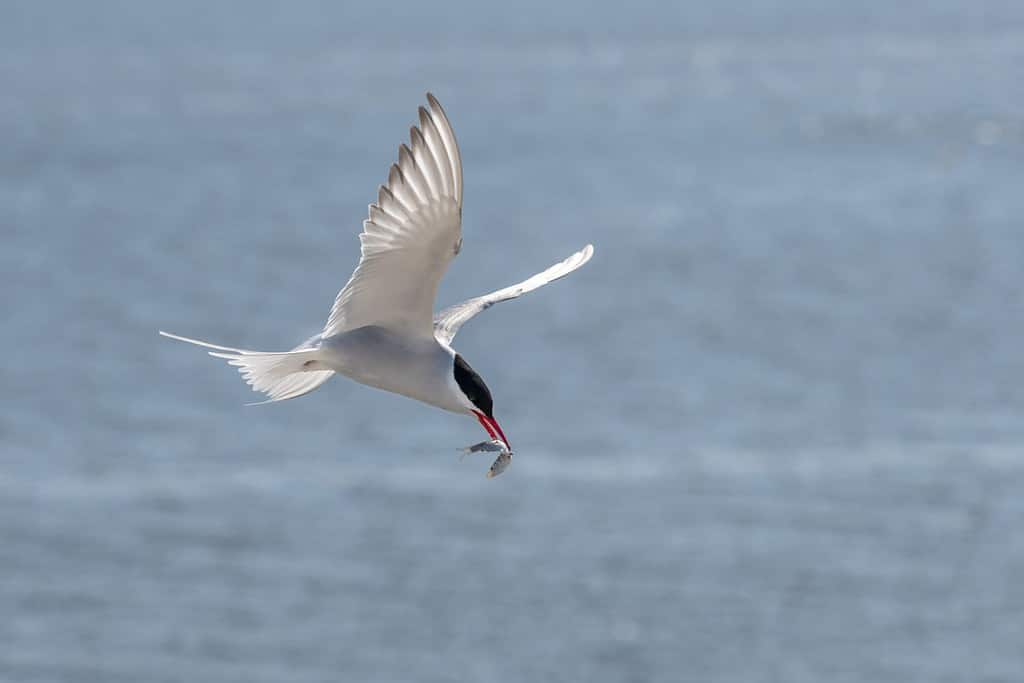
The title of the animal with the longest migration in the world goes to the Arctic tern.
©Maren Winter/Shutterstock.com
The Arctic tern is an extraordinary bird famed for the longest animal migration route in the world.
These medium-sized birds measure around 11 to 15 inches in length and have a wingspan between 26 to 30 inches. They have slim bodies, narrow wing shapes, and short legs. Their feathers are mostly a mix of grey and white, and they have red-orange beaks and feet, a white face, and a black back of the head with some white streaks. During mating season, they display a full black head along with their red beak and legs.
During the warm months in the Northern Hemisphere, you can spot them near coastlines. In the Southern Hemisphere’s warm season, they’re usually at sea, going as far as the icy waters near Antarctica.
Arctic terns mainly eat fish and marine crustaceans that are easy to catch. The fish they eat are typically young and stay close to the shore and include smaller versions of bigger sea fish like capelin, cod, and herring.
The Migration Route of the Arctic Tern
What really sets the Arctic tern apart is its migratory journey — it holds the record for the longest migration route of any bird. Recent research has found that some Arctic terns that nest in Iceland and Greenland travel about 44,000 miles annually, while those from the Netherlands travel around 30,300 miles. However, it’s possible that they may travel even more than that, and even up to double it!
Their unique travel schedule means they experience two summers every year and enjoy more sunlight than any other animal on Earth.
2. Sooty Shearwater (Ardenna grisea) – 40,000 miles

Another bird with one of the longest migrations is the sooty shearwater.
©iStock.com/hstiver
The sooty shearwater, also called tītī or muttonbird, is a remarkable sea bird famous for its long-distance migrations.
These birds are medium to large in size, with lengths ranging from 16 to 20 inches and a wingspan between 37 and 43 inches. They sport dark brown feathers that show a silvery stripe on the underwing when the light catches them just right. When flying, they skim close to the water, their stiff wings giving them a unique, wavelike motion as the wingtips nearly touch the ocean surface.
Famous for their distinct cooing and croaking calls, they are most vocal at their nesting locations. They primarily breed on small islands located in the southern Pacific and Atlantic Oceans.
In terms of diet, sooty shearwaters eat a mix of fish, crustaceans, shrimp, squid, jellyfish, and other sea creatures.
The Migration Route of the Sooty Shearwater
When it comes to migration, these birds are oceanic champions. In the Atlantic, they journey over 12,000 miles every year, going from their nesting spots in Antarctica all the way to their feeding locations in the Arctic.
Pacific sooty shearwaters go even further. Following the sun, they execute a massive figure-eight loop that takes them from New Zealand to Japan, then on to Alaska and California, clocking in more than an astonishing 40,000 miles in their yearly travels.
3. Bar-Tailed Godwit (Limosa lapponica) – 18,720 miles

With a migration route distance of 18,720 miles, the bar-tailed godwit has one of the longest migrations.
©Dave Montreuil/Shutterstock.com
The bar-tailed godwit is part of the Scolopacidae family and is known for one of the longest migration routes in the world.
During its breeding season, this bird sports striking dark red or orange feathers, long legs, and a unique upward-curving beak. When it’s not breeding, it generally has a speckled brown upper body and a smoother, beige-colored underside, although this color changes between seasons. You can identify this bird in the air by its dark wingtips and the fine stripes on its tail feathers.
This bird measures between 15 and 16 inches and has a wingspan of about 28 to 31 inches.
Commonly found along coastal areas rich in mudflats and estuaries, the bar-tailed godwit feeds on things like bristle worms and shellfish. These birds are usually seen in groups along the coast, far from their home breeding grounds in the tundra.
The Migration Route of the Bar-Tailed Godwits
The migration pattern of this bird is simply mind-boggling. Known for the longest continuous flight among birds, this creature travels a staggering 18,720 miles in a single year. Instead of flying directly back, some bar-tailed godwits take a longer route from New Zealand to the rich tidal areas of China’s Yellow Sea, where they rest and eat before finally heading to Alaska. However, others will take the most direct route from Alaska to New Zealand.
Scientists have used satellite tags to track these amazing migrations, revealing just how crucial these are for the bird’s survival and ability to reproduce.
4. Northern Elephant Seal (Mirounga angustirostris) – 13,000 miles
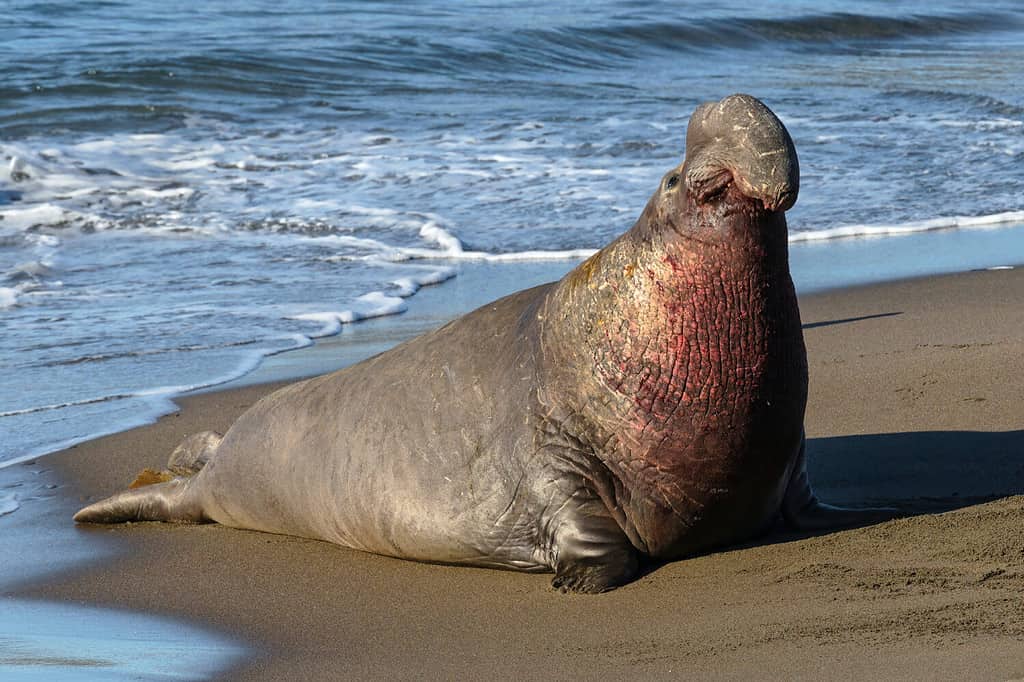
You might be surprised to learn that the northern
elephant
seal can travel up to 13,000 miles each year.
©David Osborn/Shutterstock.com
The northern elephant seal is a marine mammal well-known for its large size and extensive ocean journeys.
In the seal world, only its close relative, the southern elephant seal, is larger. The males, commonly referred to as bulls, stand out with their sizable, balloon-like noses. They usually weigh from 3,300 to 5,100 pounds and can be as long as 13 to 16 feet. However, some exceptional bulls can weigh up to 8,200 pounds. Their body features are effective for swimming and deep-sea diving.
These elephant seals mainly reside in the Pacific Ocean, traveling between beaches located in California and Mexico. Their diet is primarily composed of fish and squid.
During their time ashore for breeding, female seals abstain from eating and depend on their stored fat to nourish themselves and their offspring.
The Migration Route of the Northern Elephant Seal
What sets the northern elephant seal apart is its incredible migration distance. They travel twice a year, spanning about 6,000 miles across the North Pacific. The males usually forage in areas like the Gulf of Alaska and the eastern Aleutian Islands, while the females venture somewhat further south.
Their voyages equate to an astonishing 13,000-mile round-trip along the Pacific coastline. They spend a significant portion of the year at sea, usually between 250 and 300 days.
These extensive migrations are essential for their well-being, catering to vital needs such as food sourcing and breeding.
5. Whale Shark (Rhincodon typus) – 12,400 miles
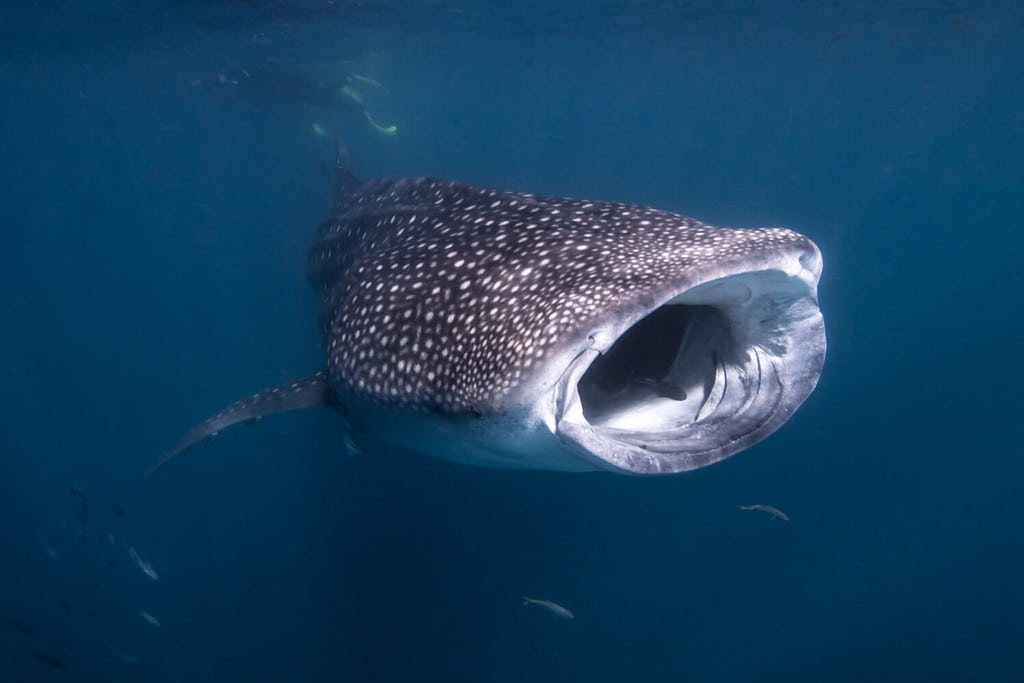
The biggest fish in the world, the whale shark can travel up to 12,000 miles or more.
©Sean Steininger/Shutterstock.com
Whale sharks are not only the biggest sharks out there but also the largest fish in existence today. Plus, they boast one of the longest migration routes in the world!
These fish can grow to a staggering 45 feet or more and tip the scales at 41,000 pounds. However, they’re generally seen at lengths ranging from 18 to 33 feet. Interestingly, each whale shark has a one-of-a-kind spot pattern, much like our fingerprints, making individual identification possible. Though their mouths can stretch up to four to five feet wide and have 3,000 tiny teeth in each jaw, these creatures don’t bite or chew
Instead, they feed by filtering more than 1,500 gallons of water an hour through their gills to capture small sea creatures like shrimp, plankton, and small fish. They favor warm ocean currents and can be found in tropical waters worldwide.
The Migration Route of the Whale Shark
These enormous fish have a regular migration path that includes the Gulf of Mexico, the northeastern Yucatán Peninsula, and the Caribbean, particularly between the months of May and September. The reason for this journey is believed to be a combination of factors like growth and better foraging.
One female whale shark set a record by swimming from the eastern Pacific all the way to the western Indo-Pacific, a trip covering a mind-blowing distance of over 12,000 miles. It’s the longest-known migration for this particular species.
6. Gray Whale (Eschrichtius robustus) – 12,000 miles

The gray whale can also travel up to 12,000 miles per year.
©ilyaska/iStock via Getty Images
Whales are not far behind sharks when it comes to animals with the longest migration routes.
Gray whales can grow to 50 feet and weigh 90,000 pounds. Their gray skin is blotchy, and instead of the usual dorsal fin, they have a hump with smaller bumps trailing down their back. These whales are filter feeders, using hair-like structures in their mouths to trap their meals from the water.
Their diet comprises small creatures residing in or above the seabed, including a variety of benthic and epibenthic invertebrates.
Most of the time, you can spot these whales near the coast, where they feed in shallow areas. They’re also known for their annual journeys along North America’s western coastline, which offers a treat for those who love to watch whales.
The Migration Route of the Gray Whale
These whales make one of the longest yearly journeys in the animal world, covering up to 12,000 miles. They start their trip in the Arctic’s nutrient-rich waters, travel to Mexico’s Baja lagoons to give birth and mate, and then head back north.
The reason behind this extensive travel? It’s to take advantage of abundant food in the Arctic and the safe, warm birthing spots in Mexico. Imagine going from San Francisco to Washington D.C., three times a year, and you’ll get an idea of how long their journey is.
7. Dragonfly (Anisoptera) – 11,000 miles

Some dragonfly species, such as the wandering glider (pictured), can travel long distances.
©Karyn Honor/Shutterstock.com
Dragonflies accomplish some of the most astounding migratory feats among all insects.
They have slender bodies and two sets of delicate wings. Their wings may be completely see-through or decorated with colorful bands. And their large heads are mostly occupied by their big, compound eyes.
These colorful critters exist in many forms, with thousands of different species brightening up the insect world.
Typically boasting a wingspan between 2 and 5 inches, dragonflies are airborne hunters that commonly live near freshwater sources. They are beneficial to ecosystems because they help control the populations of mosquitoes and other bothersome insects.
As for their diet, dragonflies primarily feast on other insects. They excel at catching their dinner right out of the air, making them very effective hunters.
The Migration Route of Dragonflies
Some types, especially those found in the eastern hemisphere, go on incredible journeys that can exceed 11,000 miles, crossing the Indian Ocean to find the perfect spots for laying eggs. Their wing structure allows them to catch wind currents and elevate themselves to heights of more than 3,000 feet.
Not only do dragonflies cover great distances, but they’re also remarkably agile fliers. They can hover in place, zip around, fly in reverse, or even upside down, reaching speeds of up to 35 mph. Each wing operates independently, allowing a dragonfly to continue flying even if it loses a wing.
8. Adélie Penguins (Pygoscelis adeliae) – 10,900 miles
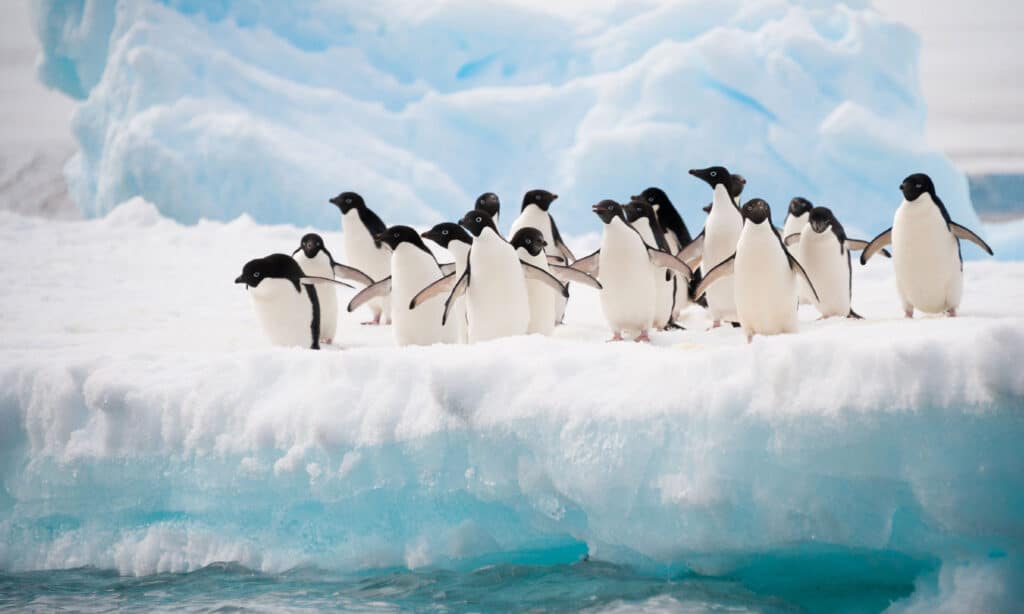
They may be small, but adélie penguins can migrate as much as 10,900 miles every year.
©iStock.com/axily
Despite being one of the smaller penguin species in Antarctica, the adélie tackles immense journeys.
Standing at a height ranging from 18 to 27.5 inches and weighing between 6 and 13 pounds, these penguins are easy to spot thanks to their unique look. They have black and white feathers, a white circle around each eye, and a black head and back. Their bodies are sleek, and their strong, flipper-like feet make them agile swimmers in chilly Antarctic waters.
They’re versatile creatures, comfortable on both land and water. They spend their summers nesting in large groups along Antarctica‘s rocky, ice-free shores. During winter, however, they head out to sea.
Fish, squid, and tiny shellfish comprise the bulk of their diet. In their search for food, they often swim across vast stretches of ocean.
The Migration Route of Adélie Penguins
Migration is a vital part of their lives, especially given the severe weather conditions of their Antarctic home. Astonishingly, some adélies are known to migrate as far as 10,900 miles in a single season, chasing the ever-present Antarctic sun.
They often travel to regions near the Ross Sea, covering average distances of up to 8,000 miles due to changing environmental factors. After their summer nesting season, they set out on a perilous eight-month journey. This migration is essential for their survival, helping them find food and escape the brutal Antarctic winter.
9. Leatherback Sea Turtle (Dermochelys coriacea) – 10,000 miles
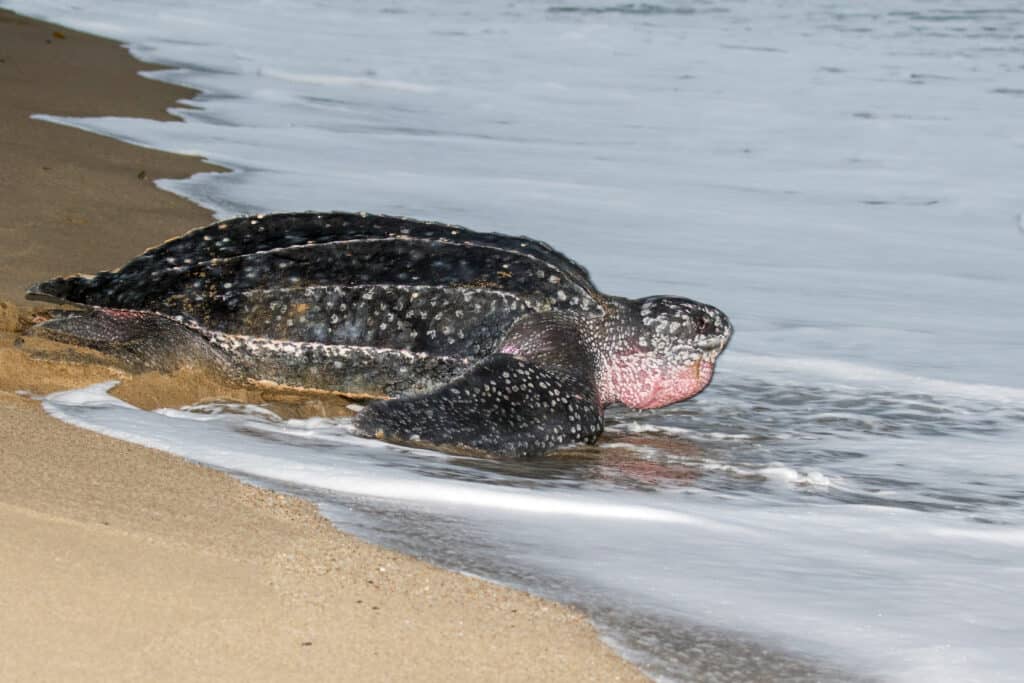
The largest
sea turtle
in existence, the leatherback sea turtle has one of the longest migration routes.
©iStock.com/AGAMI stock
Leatherback sea turtles are the biggest among the seven existing species of sea turtles, measuring over 6.5 feet and weighing as much as 2,000 pounds.
Unlike their sea turtle cousins, leatherbacks don’t have a rigid, bony outer layer. Instead, their shell is flexible and covered with skin, which is how they get their name. Their unique look includes a rounded body, a triangle-shaped head, and four large flippers. The absence of a hard shell sets them apart from other sea turtles and makes them easy to recognize.
After reaching sexual maturity around the age of around 6, these turtles return to the exact beach where they were born to lay their eggs.
You’ll find these leatherbacks in warm and moderate oceans around the globe. They mostly eat jellyfish, but they’re not picky and will munch on other soft-bodied sea creatures, too.
The Migration Route of the Leatherback Sea Turtle
Known for extraordinary migration habits, some leatherback turtles travel over 10,000 miles every year. They move from feeding areas to nesting sites, and in the Atlantic Ocean, their path can extend from Caribbean locations up to the coasts of the United States and Canada.
In a single event, one leatherback turtle was documented traveling an astounding minimum of 12,774 miles from Indonesia to Oregon, setting a record for one of the longest migrations ever observed by any marine vertebrate.
10. Humpback Whale (Megaptera novaeangliae) – 9,900 miles
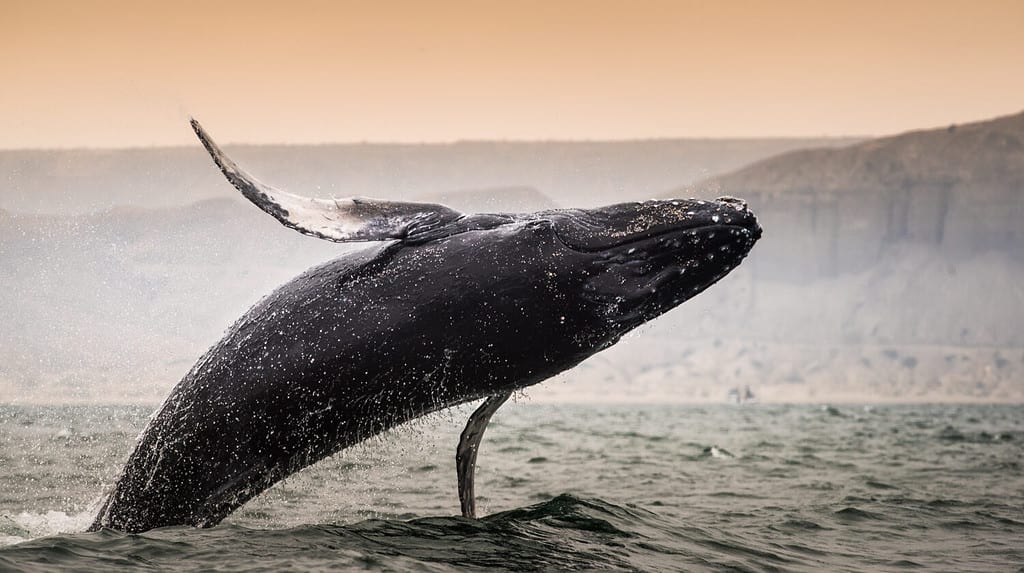
The humpback whale has one of the longest migration routes of any animal, traveling up to 9,900 miles.
©Christian Vinces/Shutterstock.com
Last on the list of 10 animals with the longest migration routes in the world is the humpback whale.
Humpback whales are easily recognizable due to their unique shape, featuring a curved back and a textured head. These sea giants can stretch from 39 to 60 feet and tip the scales at almost 80,000 pounds. Their upper side is mostly black, while their belly is white. A standout feature is their incredibly long pectoral fins, which can be as lengthy as 16 feet. You can also spot about 30 wide grooves on the underside of their neck and chest.
These whales are famous for their spectacular water shows. They can leap out of the ocean or slap the water with body parts like fins, tails, or even heads.
Found all over the globe, humpback whales can adapt to a wide range of water temperatures, from icy polar seas to tropical oceans. Their diet mainly consists of small fish and tiny shrimp-like creatures called krill.
The Migration Route of the Humpback Whale
One of the most amazing aspects of humpback whales is their extensive travels between feeding and breeding locations. These journeys can span thousands of miles each year, with some whales covering distances of up to 9,900 miles annually.
This long journey serves a dual purpose: not only does it lead them to plentiful feeding areas, but it also offers the ideal environment for mating and giving birth.
Other Animals with the Longest Migration Routes in the World
Interested to learn more about the other animals with the longest migration routes in the world? Here are a few others you should check out.
- Dorado catfish — 7,200 miles
- Bluefin tuna — 6,000 miles
- Gray wolf — 3,500 miles
- Monarch butterfly — 3,000 miles
Summary of the Animals with the Longest Migration Routes in the World
| Rank | Animal | Migration Distance |
|---|---|---|
| 1. | Arctic Tern | 44,000 miles |
| 2. | Sooty Shearwater | 40,000 miles |
| 3. | Bar-Tailed Godwit | 18,720 miles |
| 4. | Northern Elephant Seal | 13,000 miles |
| 5. | Whale Shark | 12,400 miles |
| 6. | Gray Whale | 12,000 miles |
| 7. | Dragonfly | 11,000 miles |
| 8. | Adélie Penguin | 10,900 miles |
| 9. | Leatherback Sea Turtle | 10,000 miles |
| 10. | Humpback Whale | 9,900 miles |
Thank you for reading! Have some feedback for us? Contact the AZ Animals editorial team.








